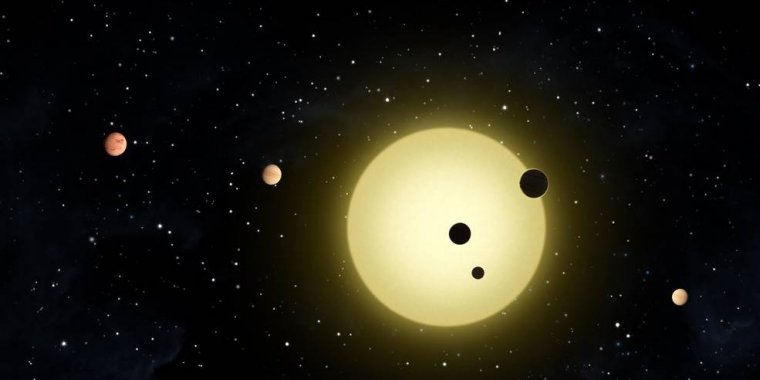| News / Science News |
Poisonous Earthly Molecule May Be Sign of Extraterrestrial Life
Researchers have found that phosphine could be a pure biosignature and a sign of life where life forms don't require oxygen to thrive.

This was the first compact solar system discovered by Kepler. Photo: NASA/JPL-Caltech
Phosphine is among the stinkiest, most toxic gases on Earth, found in some of the foulest of places, including penguin dung heaps, the depths of swamps and bogs, and even in the bowels of some badgers and fish. This putrid "swamp gas" is also highly flammable and reactive with particles in our atmosphere.
Most life on Earth, specifically all aerobic, oxygen-breathing life, wants nothing to do with phosphine, neither producing it nor relying on it for survival.
Now MIT researchers have found that phosphine is produced by another, less abundant life form: anaerobic organisms, such as bacteria and microbes, that don't require oxygen to thrive.
The team found that phosphine cannot be produced in any other way except by these extreme, oxygen-averse organisms, making phosphine a pure biosignature—a sign of life (at least of a certain kind).
"Here on Earth, oxygen is a really impressive sign of life," says lead author Clara Sousa-Silva, a research scientist in MIT's Department of Earth, Atmospheric and Planetary Sciences. "But other things besides life make oxygen too. It's important to consider stranger molecules that might not be made as often, but if you do find them on another planet, there's only one explanation."
Sousa-Silva and her colleagues are assembling a database of fingerprints for molecules that could be potential biosignatures. The team has amassed more than 16,000 candidates, including phosphine.
The vast majority of these molecules have yet to be fully characterized, and if scientists were to spot any of them in an exoplanet's atmosphere, they still wouldn't know whether the molecules were a sign of life or something else.
But with Sousa-Silva's new paper, scientists can be confident in the interpretation of at least one molecule: phosphine. The main conclusion is that, if phosphine is detected in a nearby, rocky planet, that planet must be harboring life of some kind.
In the 1970s, phosphine was discovered in the atmospheres of Jupiter and Saturn—immensely hot gas giants. Scientists surmised that the molecule was spontaneously thrown together within the bellies of these gas giants and, as Sousa-Silva describes, "violently dredged up by huge, planet-sized convective storms."
Phosphine is a molecule made from one phosphorous and three hydrogen atoms, which normally do not prefer to come together. It takes enormous amounts of energy, such as in the extreme environments within Jupiter and Saturn, to smash the atoms with enough force to overcome their natural aversion.
The researchers worked out the chemical pathways and thermodynamics involved in multiple scenarios on Earth to see if they could produce enough energy to turn phosphorous into phosphine.
"At some point we were looking at increasingly less-plausible mechanisms, like if tectonic plates were rubbing against each other, could you get a plasma spark that generated phosphine? Or if lightning hit somewhere that had phosphorous, or a meteor had a phosphorous content, could it generate an impact to make phosphine? And we went through several years of this process to figure out that nothing else but life makes detectable amounts of phosphine."
Phosphine, they found, has no significant false positives, meaning any detection of phosphine is a sure sign of life. The researchers then explored whether the molecule could be detectable in an exoplanet's atmosphere.
They simulated the atmospheres of idealized, oxygen-poor, terrestrial exoplanets of two types: hydrogen-rich and carbon dioxide-rich atmospheres. They fed into the simulation different rates of phosphine production and extrapolated what a given atmosphere's spectrum of light would look like given a certain rate of phosphine production.
They found that if phosphine were produced at relatively small amounts equivalent to the amount of methane produced on Earth today, it would produce a signal in the atmosphere that would be clear enough to be detected by an advanced observatory such as the upcoming James Webb Space Telescope, if that planet were within 5 parsecs, or about 16 light years from Earth—a sphere of space that covers a multitude of stars, likely hosting rocky planets. (Tasnim News Agency)
YOU MAY ALSO LIKE





